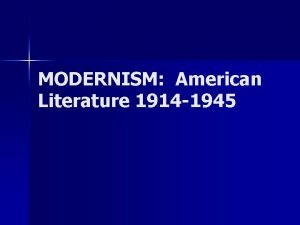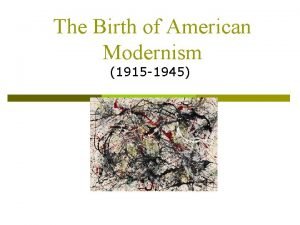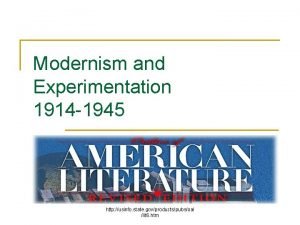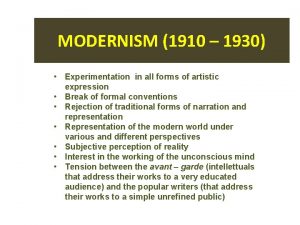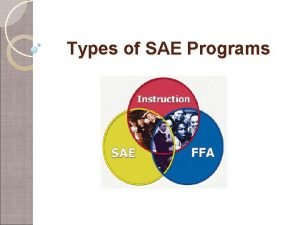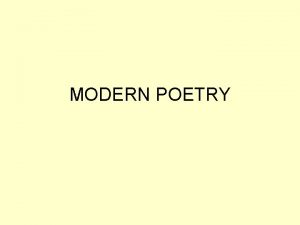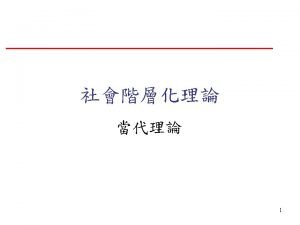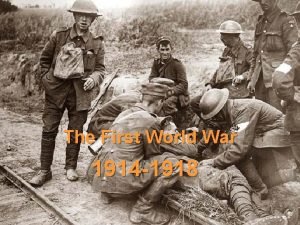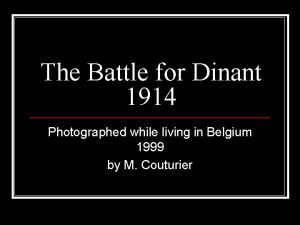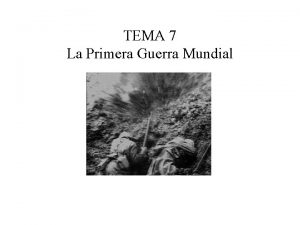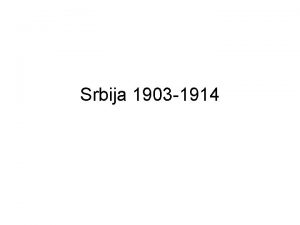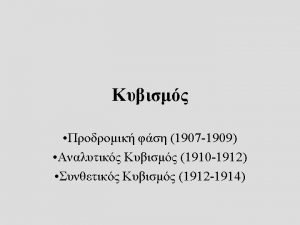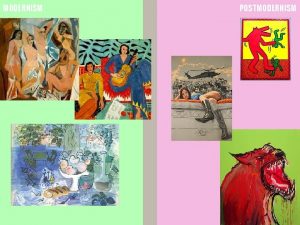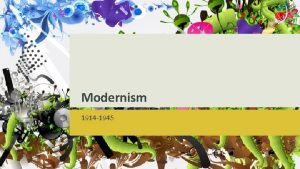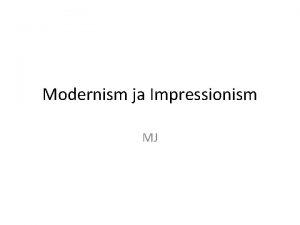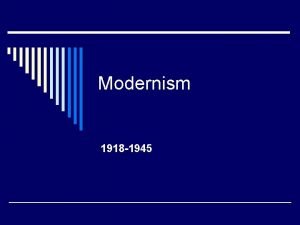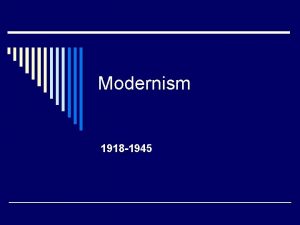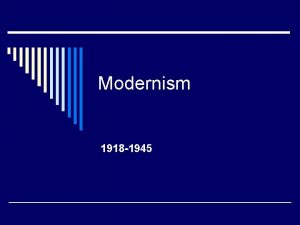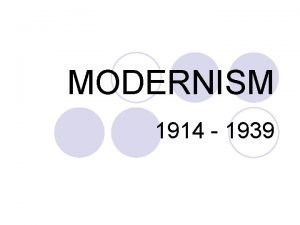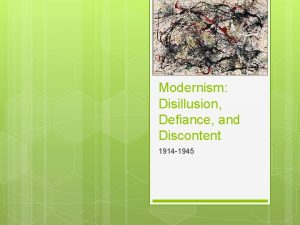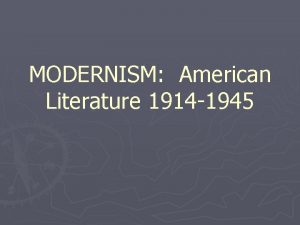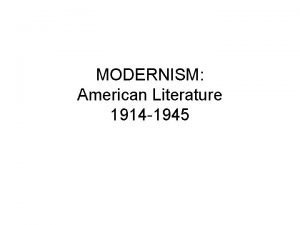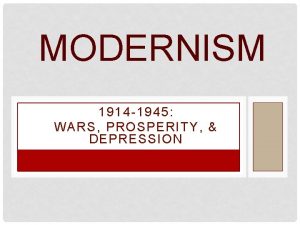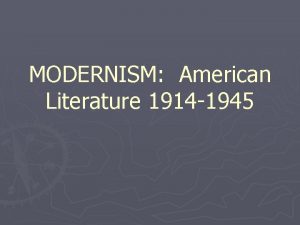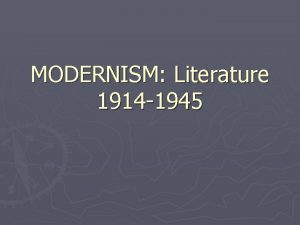Modernism and Experimentation 1914 1945 http usinfo state


















- Slides: 18

Modernism and Experimentation 1914 -1945 http: //usinfo. state. gov/products/pubs/oal /lit 6. htm

Coming of Age n Historians have characterized the period between the two world wars as the United States’ traumatic coming of age. n World War I causes disillusionment. (Destroy the ideals, illusions, or false beliefs) n Shocked and permanently changed, Americans could never regain their innocence http: //usinfo. state. gov/products/pubs/oal /lit 6. htm

WWI

1920’s: THE JAZZ AGE To F. Scott Fitzgerald it was an “age of miracles, an age of art, an age of excess, an age of satire. ”

Roaring Twenties n In love with entertainment n Movies n Prohibition was not very prohibitive (bootlegging, speakeasies, night clubs, cocktails) n Daring modes of dress and dance n Dancing, movies, automobile touring, and radio were national crazes http: //usinfo. state. gov/products/pubs/oal /lit 6. htm

Women n American women felt liberated n Many left farms and villages for homefront duty in American cities during WWI. n They cut their hair short “bobbed, ” wore shorter dresses, and glorified in the right to vote assured by the 19 th amendment passed in 1920. n They boldly spoke their mind and took public roles in society. http: //usinfo. state. gov/products/pubs/oal /lit 6. htm

Rebellion and Expatriation n Western youths rebel. n They were angry with the war, the older generation they held responsible, and difficult postwar economic conditions. n Ironically, these conditions allowed Americans with money—like writers Ernest Hemingway, F. Scott Fitzgerald, Gertrude Stein, and Ezra Pound to live abroad handsomely on very little money. http: //usinfo. state. gov/products/pubs/oal /lit 6. htm

1930’s: THE DEPRESSION “True individual freedom cannot exist without economic security and independence. People who are hungry and out of a job are the stuff of which dictatorships are made. ” – Franklin D. Roosevelt

The World Depression of 1930 s n Workers lost jobs (1/3 of all Americans out of work) n Factories shut down n Businesses and banks failed n Farmers were unable to harvest, transport, or sell crops, could not pay their debts and lost their farms http: //usinfo. state. gov/products/pubs/oal /lit 6. htm

Modernism in literature n Modernism expressed a sense of modern life through art as a sharp break from the past, as well as from Western civilization’s classical traditions. n A movement away from realism into theoretical n A breaking with conventional modes of form. http: //usinfo. state. gov/products/pubs/oal /lit 6. htm

Themes n n n Breakdown of social norms Alienation Despairing individual facing unmanageable future Urban Life Collectivism versus individualism Disillusionment Violence and alienation Decadence and decay Loss and despair Race and gender relations The American Dream

Social Norms/Cultural Sureties n n Women were given the right to vote in 1920. Hemlines raised; Margaret Sanger introduces the idea of birth control. Karl Marx’s ideas flourish; the Bolshevik Revolution overthrows Russia’s czarist government and establishes the Soviet Union. Writers begin to explore these new ideas.

The Despairing Individual n n n Characters are heroic in the face of a future they can’t control. Demonstrates the uncertainty felt by individuals living in this era. Examples include Jay Gatsby in The Great Gatsby, Lt. Henry in A Farewell to Arms

Urbanscapes n n Life in the city differs from life on the farm; writers began to explore city life. Conflicts begin to center on society.

Prose Writers: American Realism F. Scott Fitzgerald (1896 -1940) n Francis Scott Key Fitzgerald's life resembles a fairy tale. During World War I, Fitzgerald enlisted in the U. S. Army and fell in love with a rich and beautiful girl, Zelda Sayre, who lived near Montgomery, Alabama, where he was stationed. n Zelda broke off their engagement because he was relatively poor. After he was discharged at war's end, he went to seek his literary fortune in New York City in order to marry her. n The importance of facing reality became a dominant theme in his writing. He repeatedly portrayed the tragedy awaiting those who live in flimsy dreams. n Fitzgerald's secure place in American literature rests primarily on his novel The Great Gatsby (1925), a brilliantly written, economically structured story about the American dream of the self-made man. The protagonist, the mysterious Jay Gatsby, discovers the devastating cost of success in terms of personal fulfillment and love. n Major Works: The Great Gatsby http: //usinfo. state. gov/products/pubs/oal /lit 6. htm

Prose Writers: American Realism: William Faulkner (1897 -1962) n Born to southern family, William Harrison Faulkner was raised in Oxford, Mississippi, where he lived most of his life. n An innovative writer, Faulkner experimented with narrative chronology, different points of view and voices (including those of outcasts, children, and illiterates), and a rich and demanding style built of extremely long sentences full of complicated subordinate parts. n Major Works: The Sound and the Fury, As I Lay Dying, and Absalom, Absalom! http: //usinfo. state. gov/products/pubs/oal /lit 6. htm

Prose Writers: American Realism: Ernest Hemingway (1899 -1961) n Hemingway is arguably the most popular American novelist of this century. His simple style makes his novels easy to comprehend. n Hemingway often involved his characters in dangerous situations in order to reveal their inner natures. n Hemingway did not write of fatal glamour as did Fitzgerald, who never fought in World War I. Hemingway wrote of war, death, and the "lost generation" of cynical survivors. n His characters are not dreamers, they are deeply scarred and disillusioned. n Major Works: The Old Man and the Sea, For Whom the Bell Tolls, A Farewell to Arms http: //usinfo. state. gov/products/pubs/oal /lit 6. htm

Novels of Social Awareness John Steinbeck (1902 -1968) n Author concerned for the welfare of the common citizen. Focuses on disenfranchised groups of people: Professions, families, urban groups, etc. n His best known work is the Pulitzer Prize-winning novel The Grapes of Wrath (1939), which follows the travels of a poor Oklahoma family that loses its farm during the Depression and travels to California to seek work. Family members suffer conditions of feudal oppression by rich landowners. n Steinbeck combines realism with romanticism that finds virtue in poor farmers who live close to the land. His fiction demonstrates the vulnerability of such people, who can be uprooted by droughts and are the first to suffer in periods of political unrest and economic depression. n Major Works: The Grapes of Wrath, Of Mice and Men, East of Eden http: //usinfo. state. gov/products/pubs/oal/lit 6. htm
 Modernism realism
Modernism realism Modernism and experimentation in american literature
Modernism and experimentation in american literature Modernism and experimentation
Modernism and experimentation Experimentation in modernism
Experimentation in modernism Active experimentation
Active experimentation Types of sae
Types of sae R x o research design
R x o research design Field experiment
Field experiment Nurenberg code
Nurenberg code Experimentation in modern poetry
Experimentation in modern poetry Davis and moore 1945
Davis and moore 1945 What is shaded
What is shaded Európa térképe 1914-ben
Európa térképe 1914-ben Colonial empires 1914
Colonial empires 1914 Battle of dinant
Battle of dinant Imperialism map 1914
Imperialism map 1914 Site:slidetodoc.com
Site:slidetodoc.com Srbija od 1903 do 1914
Srbija od 1903 do 1914 Ma jolie
Ma jolie
